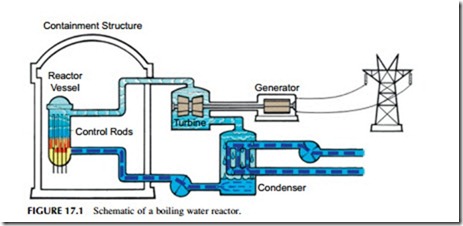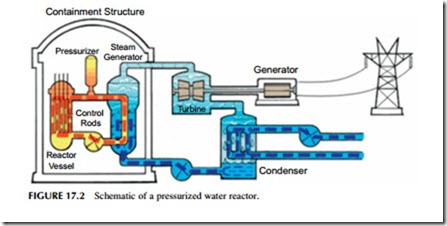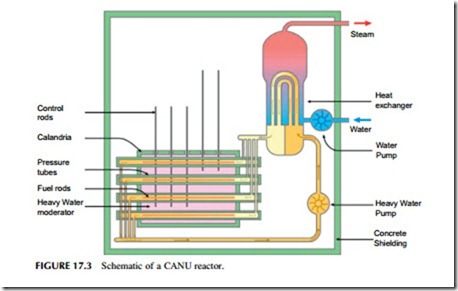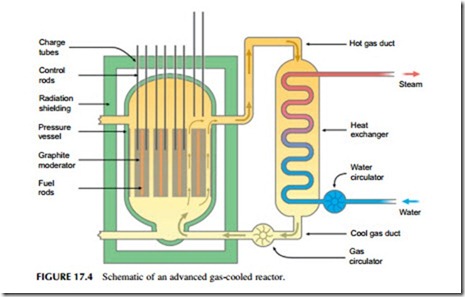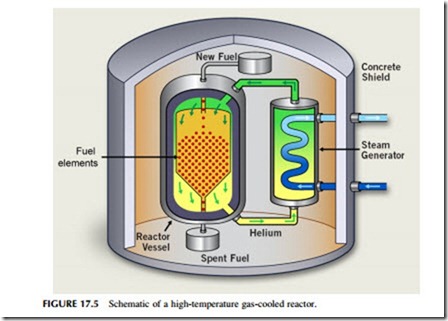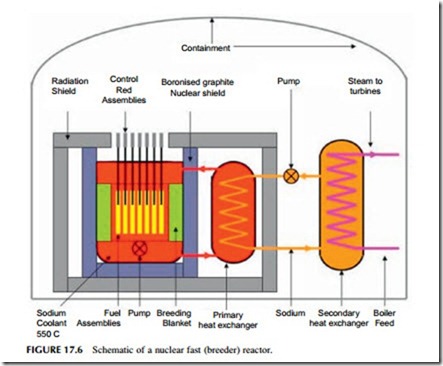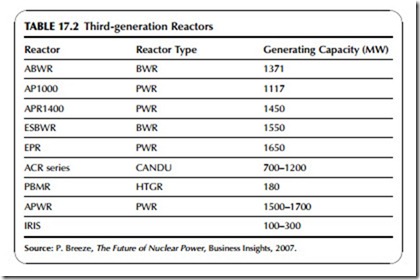NUCLEAR FISSION REACTOR DESIGNS
Nuclear reactor is the name given to the device or structure in which a controlled nuclear reaction takes place. There are a number of different designs but these have many features in common.
The core of the reactor is its heart, the place where the nuclear fuel is placed and where the nuclear reaction takes place. The fuel is most frequently formed into pellets roughly 2 cm in diameter and 1–2 cm long. These pellets are loaded into a fuel rod, a hollow tube of a special corrosion-resistant metal; this is frequently a zirconium alloy. Each fuel rod is 3–4 m long and will contain 150–200 pellets. A single reactor core may contain up to 75,000 such rods. Fuel rods must be replaced once the fissile uranium-235 they contain has been used up. This is a lengthy process that can take as much as three weeks to complete during which the reactor normally has to be shut down. However, some designs allow refuel- ing while in operation.
In between the fuel rods there are control rods, made of boron, that are used to control the nuclear reaction. These rods can be moved in and out of the core and they will be of different types. Some will be designed to completely stop the reaction in the core, others to adjust the speed of the reaction. The core will also contain a moderator to slow the neutrons released by the fission of uranium atoms. In some cases the moderator is also the coolant used to carry heat away from the core.
The outside of the core may be surrounded by a material that acts as a reflector to return some of the neutrons escaping from the core. This helps maintain a uniform power density within the core and allows smaller cores to be built. There may also be a similar reflecting material in the center of the core.
The coolant collects heat within the core and transfers it to an external heat exchanger where it can be exploited to raise steam to drive a steam turbine. The coolant may be water (light water), deuterium (heavy water), a gas such as helium or carbon dioxide, or a metal such as sodium. The core and its ancillary equipment are normally called the “nuclear island” of a nuclear power plant, while the boiler, steam turbine, and generator are called the “conventional island.” The coolant system will link the nuclear and conventional islands.
A nuclear power plant will contain a host of systems to ensure that the plant remains safe and can never release radioactive material into the environment. The most important of these is the containment. This is a heavy concrete and steel jacket that completely surrounds the nuclear reactor. In the event of a core failure the containment should be able to completely isolate the core from the surroundings and remained sealed, whatever happens within the core.
Boiling Water Reactor
The boiling water reactor (BWR) uses ordinary water (light water) as both its coolant and its moderator (Figure 17.1). In the boiling water reactor the water in the reactor core is permitted to boil under a pressure of 75 atmospheres, raising the boiling point to 285 oC, and the steam generated is used directly to drive a steam turbine. This steam is then condensed and recycled back to the reactor core. Since the steam is exposed to the core there is some radioactive contamination of the turbines, but this is short-lived and turbines can normally be accessed soon after shutdown.
This arrangement represents probably the simplest possible for a nuclear reactor because no additional steam generators are required. However, the inter- nal systems within a BWR are complex. Steam pressure and temperature are low compared to a modern coal-fired power plant and the steam turbine is gen- erally very large. BWRs have capacities up to 1400 MW and an efficiency of around 33%.
The BWR uses enriched uranium as its fuel. This fuel is placed into the reactor in the form of uranium-oxide pellets in zirconium-alloy tubes. There may be as much as 140 tonnes of fuel in 75,000 fuel rods. Refueling a BWR involves removing the top of the reactor. The core itself is kept under water, with the water shielding operators from radioactivity. Boron control rods enter the core from beneath the reactor.
In common with all reactors, the fuel rods removed from a BWR reactor core are extremely radioactive and continue to produce energy for some years. They are normally kept in a carefully controlled storage pool at the plant before, in principle at least, being shipped for either reprocessing or final storage.
The BWR was developed at the Argonne National Laboratory in the United States and a commercial version was subsequently produced by General
Electric Co. (GE). There are close to 100 BWRs in operation including four advanced BWRs in Japan and two in Taiwan.
Pressurized Water Reactor
The pressurized water reactor (PWR) also uses ordinary or light water as both coolant and moderator (Figure 17.2). However, in the PWR system the cooling water is kept under pressure so that it cannot boil. The PWR differs in another respect from the boiling water reactor; the primary coolant does not drive the steam turbine. Instead, heat from the primary water cooling system is captured in a heat exchanger and transferred to water in a secondary system. It is the water in this second system that is allowed to boil and generate steam to drive the turbine.
The core of a PWR is filled with water, pressurized to 150 atmospheres, allowing the water to reach 325 oC without boiling. The use of a second water cycle introduces energy losses that make the PWR less efficient at converting the energy from the nuclear reaction into electricity. However, the arrangement has other advantages regarding fuel utilization and power density, making it competitive with the BWR. It also allows the reactor to be more compact.
The PWR uses enriched uranium fuel with a slightly higher enrichment level than in a BWR. This is responsible for a higher power density within the reactor core. As with the BWR, the fuel is introduced into the core in the form of uranium-oxide pellets. A typical PWR will contain 100 tonnes of uranium. Refueling is carried out by removing the top of the core. However, in a PWR the control rods are inserted from above, allowing gravity to act as a fail-safe in the event of an accident.
A typical PWR has a generating capacity of 1000 MW. The efficiency is around 33%. The PWR is the most popular reactor in use globally, with over 250 in operation. The most important commercial PWR was developed by
Westinghouse for ship propulsion and later converted to power generation. The Russians developed their own version of the PWR called the VVER and units of this type continue to operate in Russia and former Soviet countries. France also developed a PWR that was based on the Westinghouse design but the designs later diverged so that the French one is now an independent design.
Pressurized Heavy Water Reactor (CANDU Reactor)
The Canadian deuterium uranium (CANDU) reactor was developed in Canada with the strategic aim of enabling nuclear power to be exploited without the need for imported enriched uranium (Figure 17.3). Uranium enrichment is an expensive and highly technical process. If it can be avoided, countries such as Canada with natural uranium reserves can more easily exploit their indige- nous reserves to generate energy. This has made the CANDU reactor, which uses unenriched uranium, attractive outside Canada too.
The CANDU reactor uses, as its moderator and coolant, a type of water called heavy water. Heavy water is a form of water in which the two normal hydrogen atoms have been replaced with two of the isotopic form—deuterium. Each deuterium atom weighs twice as much as a normal hydrogen atom, hence the name heavy water. Heavy water occurs in small quantities in natural water.3
A deuterium atom is a hydrogen atom with an extra neutron, giving it twice the mass of normal hydrogen. About 1 in every 6760 naturally occurring hydrogen atoms is a deuterium atom. The two can be separated using electrolysis that selectively splits normal water but leaves heavy water.
Heavy water is much more expensive than light water but it has the advantage that it absorbs fewer neutrons than normal water. As a consequence, it is possible to sustain a nuclear reaction without the need to enrich the uranium fuel. The CANDU reactor has the additional advantage that it can be refueled without the need to shut it down; in fact, this is necessary with natural uranium fuel to keep the plant going. Avoiding lengthy refueling shutdowns provides better operational performance.
The CANDU fuel is loaded in the form of uranium oxide pellets housed in zirconium-alloy rods that are inserted horizontally into pressure tubes penetrating the core instead of vertically as in other PWRs and BWRs. Fuel replacement involves pushing a new rod into a pressure tube that passes through the vessel containing the heavy water (called a calandria) and forcing the old tube out of the other end. Since the pressure tube is isolated from the heavy water, refueling can be carried out without the need to shut down the reactor.
The heavy water coolant in the CANDU reactor is maintained under a pressure of around 100 atm and the water reaches around 290 oC without boiling. Heat is transferred through a heat exchanger to a light water system with a steam generator and the secondary system drives a steam turbine in much the same way as a PWR. Efficiency is similar too.
The CANDU reactor was developed by Atomic Energy of Canada, and that country has the largest CANDU fleet, but reactors have also been supplied to countries such as Argentina, South Korea, India, and Pakistan. There are around 40 in operation.
Gas-cooled Reactors
When searching for their own design of reactor that did not require enriched uranium, U.K. scientists developed the Magnox reactor. This reactor uses a graphite moderator and carbon dioxide as the heat-transfer medium. The latter carries away heat generated in the moderator to a heat exchanger where it is used to heat water and raise steam to drive a turbine. Channels in the graphite moderator contain tubes made of magnesium alloy (from which the reactor takes its name) into which uranium fuel is loaded.
The United Kingdom built nine Magnox reactors, all of which were different, and units were also built in Japan and Italy. A second generation of gas- cooled reactors, called advanced gas-cooled reactors (AGRs), were developed in the Untied Kingdom during the 1960s and seven of these were built (Figure 17.4). These retained the graphite moderator and carbon dioxide coolant but opted for 2% enriched uranium fuel housed in zirconium-alloy rods. The gas coolant in the AGR reaches 650 oC and the gas is then circulated through steam generator tubes outside the core.
The advantage of the AGR is that higher temperatures in the core can potentially provide for a higher efficiency of power generation. However, the U.K. fleet of gas-cooled reactors has not proved as successful, operationally, as
Gas circulator
alternative designs. No more U.K. AGR reactors are planned and the last reactor to be built in the United Kingdom was a PWR.
RBMK Reactor
The RBMK reactor is a Russian design that uses a graphite moderator and water as the coolant. Like a BWR, the water is maintained under pressure but allowed to boil around 290 oC and the steam generated is pumped through steam tur- bines to generate power.
The Soviet Union built 17 of these reactors between 1973 and 1991 during which the design continuously evolved. It was one of these reactors that failed at Chernobyl, with dramatic consequences. It is now known that a major design flaw contributed to the accident. Eleven of these reactors continue to operate, all in Russia.
High-temperature Gas-cooled Reactor
The high-temperature gas-cooled reactor (HTGR) is similar in concept to the AGR (Figure 17.5). It uses uranium fuel, a graphite moderator, and a gas as coolant. In this case, however, the gas is helium.
Several attempts have been made to build reactors of this type but none has so far entered commercial service. Early development work was carried out in the United States. The U.S. design utilized fuel elements in the shape of inter- locking hexagonal prisms of graphite containing the fissile material. HTGR fuel
is often much more highly enriched than the fuel in a water-cooled reactor, with up to 8% uranium-235. The arrays of hexagonal graphite prisms contain shafts for control rods and passages for the helium to pass through and carry away the heat generated by fission.
Another design, developed in Germany, uses uranium-oxide fuel that is sealed inside a graphite shell to form a billiard ball-sized fuel element called a pebble. This gives the reactor its name: the pebble-bed reactor. Development of this in Germany was eventually abandoned but the idea was taken up during the 1990s by the South African utility Eskom, which continued development until 2010 when it appears to have been halted. Japan and China have funded experimental programs too.
The advantage of the HTGR is that both the moderator, graphite, and the coolant (helium) can operate at high temperatures without reacting or deteriorating. A typical HTGR will operate at a pressure of 100 atm and at a temper- ature up to 900 oC. This enables better thermodynamic conditions to be achieved, leading to higher efficiency. The reactor is designed so that in the event of a coolant failure it will be able to withstand the rise in internal temperature without failing.
The HTGR can use a dual-cycle system in which the helium coolant passes through a heat exchanger where the heat is transferred to water and steam is generated to drive a steam turbine. This arrangement is around 38% efficient. However, a more advanced system uses the helium directly to drive a gas turbine. This arrangement is sometimes called a gas turbine modular helium reactor (GT-MHR). In theory, the GT-MHR can achieve an energy conversion efficiency of 48%.
One of the advantages of the HTGR is that it can be built in relatively small unit sizes. Modules can have generating capacities between 100 MW and 200 MW, making it attractive for a wider variety of applications. The modular form of most designs also makes it easy to expand a plant by adding new mod- ules. However, no reactors of this design have yet entered commercial service.
Nuclear Fast (Breeder) Reactors
A conventional fission reactor can only use uranium-235 as fuel. Another type of reactor, called a breeder or fast reactor, aims to utilize the much more abundant uranium-238, but since this is stable under normal conditions it has to be approached in a circuitous way (Figure 17.6).
The breeder reactor uses not uranium but plutonium as its primary fuel. This decays or splits when bombarded with neutrons in a similar way to uranium- 235, producing fast neutrons and two smaller nuclei. However, whereas in the conventional uranium-235 reactor the fast neutrons must be slowed with
a moderator to enable further nuclear fusion reactions to take place, plutonium will interact with the fast neutrons so no moderator is required.
The absence of a moderator means that there is an abundant supply of fast neutrons available. Some of these neutrons can be harnessed to produce more fuel because a uranium-238 atom will interact with a fast neutron to form an atom of plutonium. The core of a breeder reactor is surrounded with uranium-238, and by careful design the reactor can be made to produce more plutonium than it uses, hence the name (the alternative name, fast reactor, comes from its use of fast neutrons).
A breeder reactor needs an initial supply of plutonium. This can be obtained by processing the spent fuel from a conventional reactor where some plutonium is formed when fast neutrons interact with uranium-238 atoms before they are slowed. Once the reactor has started, it should provide its own source of fuel. However, a breeder reactor requires an allied fuel reprocessing plant.
Most breeder reactors use liquid sodium as the coolant because this does not slow the neutrons. A number of prototypes have been built, the most recent in France and Japan. However, the coolant has often proved to be a source of major problems and no commercial breeder reactor has ever been built.
There is a second type of breeder reactor called a thermal breeder reactor. This uses a rare isotope of uranium, uranium-233, as its fissile material. When bombarded with slow neutrons uranium-233 undergoes a fission reaction similar to uranium-235, producing fast neutrons that are then slowed by a moderator. The core of the thermal breeder reactor is surrounded with thorium. This also reacts with slow neutrons to produce more uranium-233. The thermal breeder is simpler than the fast breeder because it can use water both as its moderator to slow the fast neutrons and as its coolant. This design has been developed in India where there are large reserves of thorium.
Advanced Reactors
With the imminent demise of the gas-cooled reactor in the United Kingdom and with no more RBMK reactors likely to be constructed, all the major commercial reactor designs are now water cooled. The PWR, BWR, and CANDU reactors described earlier are all what are known as second-generation designs. Each of these has led to at least one third-generation design and some of these have been or are being built.
The aim of third-generation reactors is to improve the safety of nuclear power generation and at the same time to reduce construction costs. Many of them were originally conceived during the 1980s and available for construction during the 1990s, but none was built until the 21st century.
To make construction simpler, companies have developed standardized designs that they have sought to have certified in different regions of the world. Approval by a nuclear certification authority should mean that, in principle, the planning application for construction of such a plant will be streamlined.
The main safety advance in third-generation reactors is to design them with passive safety features such that in the event of any type of failure the reactor will be capable of shutting itself down without the need for intervention. Such features are seen as crucial to gaining continued public acceptance of nuclear power.
One of the main new reactors is the advanced boiling water reactor (ABWR), designed by GE and based on its widely used BWR. It has been certified for use in both the United States and in Europe. Four ABWR reactors are operating in Japan and two in Taiwan. Others are planned.
The AP1000 is an evolution of the Westinghouse PWR with passive features intended to reduce construction costs. The first version, the AP600 with a generating capacity of 600 MW, was certified in the United States in 1999. The 1117 MW version, the AP1000, was approved in the United States in 2005. Four units based on this design are under construction in China and the construction of units in the United States has been approved. An evolution of the AP1000 has also been developed for the Chinese market. Called the CAP1400, it has a generating capacity of 1400 MW. China is expected to approve construction of a plant to this design and the Chinese National Nuclear Corp. is also hoping to export the technology.
The APR1400 is based on the Korean Standard Nuclear Power Plant developed by the Korean Electric Power Co. The design of the latter was originally based on the Combustion Engineering System 80 + design, now owned by Westinghouse. Two APR1400 units are under construction in South Korea.
The only third-generation reactor under construction in Europe is the European pressurized water reactor (EPR) also known in the United States as evolutionary pressurized water reactor. This is an evolution of the French PWR together with a German reactor design and has a generating capacity of 1650 MW, the largest of any commercial reactor. The design is being mar- keted by French company Areva. One is under construction in Finland, one in France, and two in China. The design is seeking certification in the United States and United Kingdom.
The economic simplified BWR (ESBWR) is another evolution of GE’s BWR and has been developed by GE and Hitachi. It further refines the passive elements of the ABWR. The design is seeking certification in the United States. None has been built.
The third generation of the CANDU reactor is the ACR series. Two units have been designed: the ACR700 with a generating capacity of 700 MW and the ACR1200 with a capacity of 1200 MW. One of the innovations of the design is to use heavy water in the core but with a light water circuit to extract heat. The reactors would also use uranium enriched to 1.5–2%.
The pebble-bed modular reactor (PBMR) is based on the pebble-bed design described before. It was being developed by a company called PBMR, an affil- iate of the South African utility Eskom, but the South African government decided to stop funding for the project in 2010. Its future now looks in doubt.
The advanced PWR (APWR) has been designed by Mitsubishi. It has a potential generating capacity up to 1700 MW. A special version called the US-APWR has been designed for the U.S. market.
A new reactor still under development is the international reactor innovative and secure (IRIS), which is the product of an international consortium involving nine nations. The reactor is small, with a unit size of 100–300 MW. It will have a range of passive features. One of the key innovations is to use uranium enriched to between 5% and 9% so that refueling would only be required every five years.
In addition to these third-generation designs, there are a number of more complex and advanced fourth-generation designs being considered. (Both the PBMR and IRIS might be considered fourth-generation designs.) However, there are economic and political arguments for sticking with the best of the existing second- and third-generation designs since these require minimal fuel recycling and provide less danger of nuclear proliferation.
